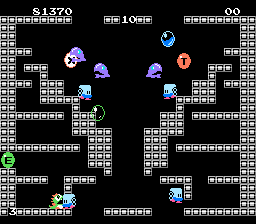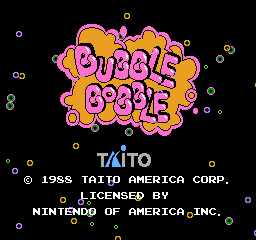Bubble Bobble is a single-screen arcade game with 100 levels. It emphasizes two players, though it's also fun solo. The premise is that you control little dragons (named Bub and Bob) that shoot bubbles that can envelop enemies. Popping a bubble with an enemy in it destroys that enemy. If you take too long, however, the bubble eventually pops and releases the enemy.
Each screen has a unique layout of platforms and walls. The enemies are cute, like little clockwork guys (Bubble Buster) and ghosts (Stoner). Most are easily beaten, but a few have projectiles. The hardest enemies are Invaders, who shoot downward like in Space Invaders, and Willie Whistle, who throws a bottle that boomerangs. If you don't finish a stage within a certain time limit, an invincible, skeletal whale called Baron von Blubba appears and chases you. A simple password system lets you conveniently continue on any level.
A distinctive element of Bubble Bobble is the many bonus items that appear (though the NES version doesn't have as many as the arcade original). The most common are fruits that give points, but there are also power-ups. For example, various candies augment the dragons' attack, umbrellas warp them ahead, shoes speed them up, and crosses destroy enemies all over the screen. Items stay on the screen for only a short time. Sometimes a huge food item worth thousands of points will drop after clearing a stage. There are also letters to collect, which spell "extend." If you get them all, the current stage ends and you get an extra life. Certain levels contain elemental effects: bubbles that shoot lightning, release a cascade of water, or drop fire. The appearance of items seems random, so it's exciting when the more desirable ones appear.
Bub and Bob can bounce on their bubbles. This skill is needed in later stages to reach platforms above. On almost all stages, there are gaps in the bottom of the screen that wrap around back to the top. It's important to be mindful of enemies passing between the top and bottom.
The 100th stage contains a final battle against a huge enemy called Grumple Gromit. To hurt him, Bub and Bob must drink a potion that turns their bubbles into lightning bubbles. When these bubbles are popped, a bolt of lightning shoots across the screen, which can hurt the boss. It's a fun fight and a great way to end a great game.
The NES version has a peculiar ending. When you beat Grumple Gromit, it says you need to grab a crystal ball (on level 99) to get the "happy" ending. It's hard to get the crystal ball before it disappears, but if you do, you advance to a series of twelve bonus levels. Clearing these lets you see the true ending—but only if there's a second player. If you beat it solo, the ending tells you to play again with a friend!
Bubble Bobble is famous for its ear-worm background music. Despite being a short loop that plays over all 100 levels, it somehow never grows old. In fact, the music is one of the highlights of the game!
Bubble Bobble is a simple game. Its fast action, variety, gentle difficulty curve, cute graphics, and catchy music combine to create a surprisingly fun package. It's lost none of its charm over the last four decades and is as fun as ever, especially with a second player. Over the weekend my 10-year-old daughter and I sat down and played all 100 levels in one sitting. It may not sound like much on paper, but once you play Bubble Bobble, it's hard not to love it.
 |
| Grade: A |
Linked Reviews
"With Bubble Bobble’s simultaneous 2-player gameplay, 100 stages of increasing difficulty and manic platform gameplay this is certainly one of the better games from the NES console."
— Anonymous, Nintendo Life, 8/10
"Bubble Bobble actually encourages you to bring a friend along on your journey – only with the cooperation of two talented players can you access the game's extra stages and alternate ending."
— IGN, #23 of Top 100
"The whole affair is fast-paced, frantic, and fun from the start, and luckly the controls are snappy and responsive."
— Pat Contri, Ultimate Nintendo: Guide to the NES Library, 4.5/5
"Bubble Bobble stood at the vanguard of a newly reinvigorated Taito that attacked the mid-80's with appealing, innovative games."
— Jeremy Parish, NES Works






Comments
Post a Comment